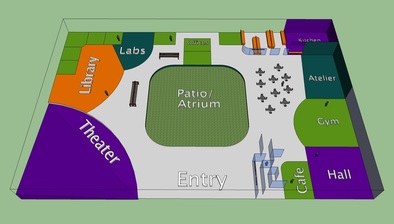Building Sustainability
“The very essence of architecture is reminiscent,
varied and developing, of natural organic life. This is the only true style in architecture.” (Alvar Aalto) Sustainability is a matter of equilibration, and that makes necessary to keep a global view to get sustainable solutions. Therefore, to ensure sustainability of the project, it is essential to have a green and energy self-sufficient building. We have established the following guidelines to achieve this goal: Use of old and in disuse buildings through rehabilitation: The cost of a building structure accounts for 40% of the final cost of the building, so using an existing structure means significant savings in the initial investment required. In case of using abandoned industrial buildings, this will revitalize old industrial areas, deteriorated for lack of industrial activity. These areas will become significant places for the community with intensive cultural and social activity. In case of Public Schools, there is a possibility for the recovery of disused public buildings. In many cases, the maintenance of unused buildings is a significant expense in the budgets of cities or towns. Incorporation of Building Management Systems: This ensures proper management of energy, resulting in a reduction of the cost of building maintenance. Include green spaces: Contact with nature is a fact of main importance for a healthy development, so the building must include gardens or orchards that allow contact with nature as well as the opportunity to experience the natural processes through direct observation. If there is no possibility to have green areas around the building, we propose, an accessible vegetative cover on the roof. That is also useful in terms of energy saving and rainwater recycling, so the possibility is also recommended for buildingswith open atrium and/or gardens around. |
Bioclimatic design:
This means to adapt the orientation and design of the building, windows and shields, as well as the selection of construction materials, to the climatic conditions of the place. This maximizes the use of the sun and wind as natural energy sources to achieve climatic and lighting comfort in the building, reducing energy needs. Use of renewable energy: An appropriate design of energy production systems fed with natural sources, such as solar, geothermal and wind can meet the energy needs of the building. Use of green materials: The use of natural materials, coming from controlled and balanced production, as well as recycled materials, reduces the energy consumption needed for the construction of the building, and reduces generated pollution. |
 |
|




